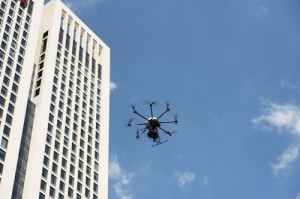(Source: Washington Post)

Drones are looming on the horizon these days: lurking on the border, looking for missing children and delivering beer. Public opinion on whether this is a good or bad thing varies widely. The legal issues surrounding our drone future are similarly unsettled. Thanks to the hospitality of the Volokh Conspiracy, we’ll be exploring the legal and policy dimensions of domestic drone use all week, with a special focus on the use of drones for journalistic purposes — we are media lawyers, after all!
Drones for journalistic use — journo-drones, as we’ll call them — have been on the scene since at least 2011, when the Daily, News Corp.’s now-defunct tablet newspaper, flew camera-equipped drones to survey the devastation wrought by tornadoes in Alabama.(The Federal Aviation Administration was not impressed.)
Since then, journo-drones have demonstrated their capabilities as one of the newest tools of the journalist trade. For example, in 2012 a hobbyist flying his drone over the Trinity River in Texas noticed a nearby creek with red rivulets, which, upon closer inspection, were streams of pig blood flowing from a local slaughterhouse. The footage prompted a lengthy investigation. Likewise, in 2013, while Colorado was in the midst of horrific rains and flooding, a private company used drones to map the floods in an effort to educate the public. And in Australia, one media company used a drone to observe refugee encampments on Christmas Island after being denied permission to view the area.
Journalists are eager to use drones in their reporting for many reasons. Here are a few:
Vantage point. First, and most obviously, drones have the ability to capture incredible images, offering vantage points that previously could only be accessed at great expense. Unlike aerial footage from news helicopters, drones offer viewpoints that previously were unimaginable. The Daily’s footage of tornado damage illustrates this advantage: Although on-the-ground reporting might have given a close-up of the outside of destroyed buildings, and helicopter imagery could have displayed the destroyed horizon, the Daily’s news drones were able to switch between those vantage points, offering people perspectives that otherwise could never have been seen. Indeed, many of the places the drone surveyed were not accessible to people, at least not safely. In addition to their visual capabilities, drones can be equipped with an array of sensors to gather data about weather, temperature and radiation, as well as other environmental information.
Drones — better known in the technology industry and among regulators as small unmanned aircraft systems (sUAS) — come in a variety of shapes and sizes. Some look like model airplanes, while others look nothing like the manned aircraft we have seen in the past, taking the form of futuristic mini-spaceships with multiple rotors. From what we’ve seen, most journalists are interested in drones that span less than a few feet in diameter and weigh only a few pounds. The advantage of such drones over helicopters is clear: Their small size permits accessibility to otherwise hard-to-reach areas, allowing versatility in vantage points that range seamlessly from up above to up close, into tight spots and in between obstacles.
Cost. Today, a small Parrot AR drone, which can fly a few hundred feet in the air for about 15 minutes, costs only $300. The cost of a more sophisticated drone can range from roughly $1,000 to $40,000, depending on its size, the distance it can travel and the time it can stay in the air. By way of comparison, operating a helicopter for news coverage costs approximately $1,000 per hour, including the cost of the personnel required to fly it.
Safety. Unmanned drones can eradicate the need for placing humans in harm’s way when reporting on natural disasters and other dangerous events, making on-the-scene reporting possible as never before. For example, drones can easily fly over forest fires, through the aftermath of a typhoon and even into erupting volcanoes, all without risking human life.
As a result,the demand for drones is growing exponentially. The technology is developing just as rapidly, building on drones’ advantages and minimizing their risks.
The law has not kept pace, lurching forward in fits and starts. Federal regulators have not moved quickly enough to accommodate this nascent industry or to safely integrate drones into American airspace. Though drone enthusiasts, including the media, want the FAA to issue regulations to provide some clear and comprehensive guidance, that has yet to happen.
Continue Reading at WashingtonPost.com…
Alan is serial entrepreneur, active angel investor, and a drone enthusiast. He co-founded DRONELIFE.com to address the emerging commercial market for drones and drone technology. Prior to DRONELIFE.com, Alan co-founded Where.com, ThinkingScreen Media, and Nurse.com. Recently, Alan has co-founded Crowditz.com, a leader in Equity Crowdfunding Data, Analytics, and Insights. Alan can be reached at alan(at)dronelife.com